級内相関係数 ICC Case2 の計算とサンプルサイズ計算を R でやってみた
級内相関係数 ICC(2,1) の計算例
級内相関係数 Intra-class Correlation Coefficient Case2 ICC Case2 は検者間信頼性の指標。
患者さんを数名の検査者(または評価者)で検査(または評価)して、その測定値の一致性を見るのが主目的。
複数の検査者が各患者さん 1 回ずつ検査・評価した場合の ICC(2,1) が良く用いられる。
9人の患者さんをA~Eの5人の検査者で1回ずつ検査した時
irrパッケージのicc()を使う。
最初一回だけインストールする。
install.packages("irr")
データ拝借元:級内相関係数|統計解析ソフト エクセル統計
A <- c(0,2,2,1,3,0,4,4,6)
B <- c(0,4,1,2,3,1,5,4,6)
C <- c(0,2,0,0,3,0,4,4,6)
D <- c(0,2,2,1,3,0,4,5,4)
E <- c(0,3,2,1,3,0,4,4,6)
dat.twoway <- cbind(A,B,C,D,E)
rownames(dat.twoway) <- c(1:9)
print(dat.twoway)
library(irr)
icc(dat.twoway, model="twoway", type="agreement")
読み込んだデータは以下のようになっている
> print(dat.twoway)
A B C D E
1 0 0 0 0 0
2 2 4 2 2 3
3 2 1 0 2 2
4 1 2 0 1 1
5 3 3 3 3 3
6 0 1 0 0 0
7 4 5 4 4 4
8 4 4 4 5 4
9 6 6 6 4 6ICC(2,1) の計算結果は以下の通り。
> icc(dat.twoway, model="twoway", type="agreement")
Single Score Intraclass Correlation
Model: twoway
Type : agreement
Subjects = 9
Raters = 5
ICC(A,1) = 0.906
F-Test, H0: r0 = 0 ; H1: r0 > 0
F(8,32.8) = 55.6 , p = 6.98e-17
95%-Confidence Interval for ICC Population Values:
0.783 < ICC < 0.974ICC(2,1)は、0.906と計算された。
高い一致度だ。
患者さん10人をA~Dの4人の検査者で膝関節屈曲可動域を検査した時
別のデータでICC(2,1)を計算してみる。
患者さん10人、A~Dの4人の検査者で、膝関節屈曲可動域を検査したデータだ。
データ拝借元:信頼性指標としての級内相関係数
A <- c(126,137,113,153,146,161,110,145,126,114)
B <- c(122,143,119,143,157,157,109,151,141,126)
C <- c(131,141,115,135,150,160,105,152,132,130)
D <- c(125,141,105,144,149,160,113,156,122,125)
dat.twoway <- cbind(A,B,C,D)
rownames(dat.twoway) <- c(1:10)
print(dat.twoway)
icc(dat.twoway, model="twoway", type="agreement")
データは以下のような感じになる
> print(dat.twoway)
A B C D
1 126 122 131 125
2 137 143 141 141
3 113 119 115 105
4 153 143 135 144
5 146 157 150 149
6 161 157 160 160
7 110 109 105 113
8 145 151 152 156
9 126 141 132 122
10 114 126 130 125計算結果は以下の通り。
> icc(dat.twoway, model="twoway", type="agreement")
Single Score Intraclass Correlation
Model: twoway
Type : agreement
Subjects = 10
Raters = 4
ICC(A,1) = 0.909
F-Test, H0: r0 = 0 ; H1: r0 > 0
F(9,30) = 40.4 , p = 2.46e-14
95%-Confidence Interval for ICC Population Values:
0.788 < ICC < 0.973ICC(2,1)は0.909と計算された。
こちらも一致度が高い。
irrパッケージのanxietyデータを使った例
20人の患者さんを3人の評価者が評価した結果のICC。
data(anxiety)
print(anxiety)
icc(anxiety, model="twoway", type="agreement")
anxiety データセットは以下のとおり
> print(anxiety)
rater1 rater2 rater3
1 3 3 2
2 3 6 1
3 3 4 4
4 4 6 4
5 5 2 3
6 5 4 2
7 2 2 1
8 3 4 6
9 5 3 1
10 2 3 1
11 2 2 1
12 6 3 2
13 1 3 3
14 5 3 3
15 2 2 1
16 2 2 1
17 1 1 3
18 2 3 3
19 4 3 2
20 3 4 2ICC(2,1)は0.198とかなり低い一致度。
> icc(anxiety, model="twoway", type="agreement")
Single Score Intraclass Correlation
Model: twoway
Type : agreement
Subjects = 20
Raters = 3
ICC(A,1) = 0.198
F-Test, H0: r0 = 0 ; H1: r0 > 0
F(19,39.7) = 1.83 , p = 0.0543
95%-Confidence Interval for ICC Population Values:
-0.039 < ICC 8< 0.494級内相関係数 ICC(2,1) の解釈
一つには、以下のような基準があるので参照されたい
| ICC | 解釈 |
| < 0.5 | Poor |
| 0.5 – < 0.75 | Moderate |
| 0.75 – < 0.9 | Good |
| >= 0.9 | Excellent |
出典:A Guideline of Selecting and Reporting Intraclass Correlation Coefficients for Reliability Research
級内相関係数 ICC(2,1) のサンプルサイズ計算
級内相関係数 ICC(2,1) のサンプルサイズ計算はどうやるのだろうか?
参考文献 Doros G. and Lew R. Design Based on Intra-Class Correlation Coefficients. Am J Biostatistics 2010: 1 (1); 1-8.に計算結果が掲載されている。
検査者が3人、5人、7人、10人のとき、信頼区間全体の平均幅 $ \Delta $ が0.2、0.3、0.4のときのサンプルサイズが計算されている。
信頼区間の有意水準が10%($ \alpha $ = 0.1)のときと5%($ \alpha $ = 0.05)の時が計算されている。
ICC(2,1)の推定値 $ \rho $ が0.6、0.7、0.8のときがそれぞれ計算されている。
例えば、検査者が3人(k=3)で、信頼区間幅が0.4で推定したいとする。
有意水準5%つまり95%信頼区間で推定するとして、$ \rho $ が 0.8 と推定されるとすると、必要なサンプルサイズ(患者さんの人数)は14人である。
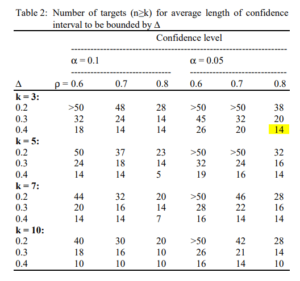
参考文献にはスクリプトの請求が可能と書いてあった。
論文に掲載されていない数値に関しては、各自スクリプトを取り寄せて、スクリプトを確認の上、計算してもらいたい。
計算における注意点
実際の計算には、variance ratio $ \sigma_T^2 / \sigma_E^2 $ 、想定する ICC(2,1) の値 $ \rho $ が必要になる。
$ \rho $ と variance ratio には、以下の関係がある。
$$ \rho = \frac{\sigma_T^2 / \sigma_E^2} {\sigma_T^2 / \sigma_E^2 + \sigma_J^2 / \sigma_E^2 + 1} $$
ここで、
- $ \sigma_T^2 $: variance of normally distributed random target effects(目標とする効果の分散)
- $ \sigma_J^2 $: variance of normally distributed random rater effects(評価者効果の分散)
- $ \sigma_E^2 $: variance of normally distributed measurement errors(誤差の分散)
である。
論文中では、variance ratio を pilot study から持ってきている。
Pilot study がない場合、この variance ratio を見極めるのが難しそうだ。
まとめ
級内相関係数 ICC(2,1) の計算例とサンプルサイズ計算の方法を解説した。
参考になれば。
参考文献
A Guideline of Selecting and Reporting Intraclass Correlation Coefficients for Reliability Research
参考サイト・PDF
Sample Size Determination for ICC(2,1)
How should we calculate sample size for ICC(2,1) analysis?
A part of sample size calculation for ICC(2,1) with certain conditions were published in the following scientific article:
The article showed results of sample size calculation under the condition estimating the confidence intervals of 0.2, 0.3, or 0.4 with two, three, or four raters.
Results with 10% and 5% of alpha levels were exhibited in Table 2 of the article.
Estimates $ \rho $ of 0.6, 0.7, or 0.8 were demonstrated.
For example, if you would estimate $ \rho $ = 0.8 with 0.4 of 95% confidence interval rated by four examiners, 14 patients would be needed as we can see a highlighted number in the following.
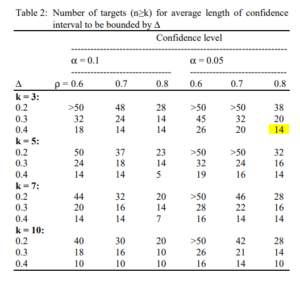
The reference said anyone can request R scripts for the calculation.
Please obtain and confirm the scripts, and perform calculation individually for any settings not included in the paper.





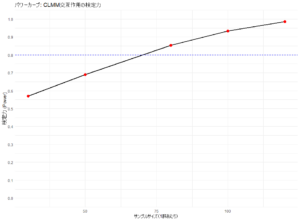
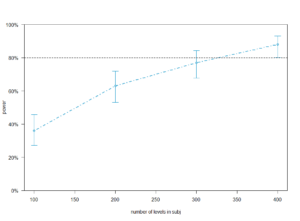
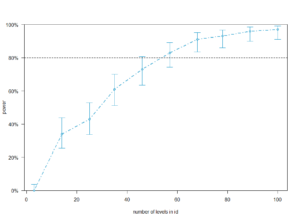
コメント